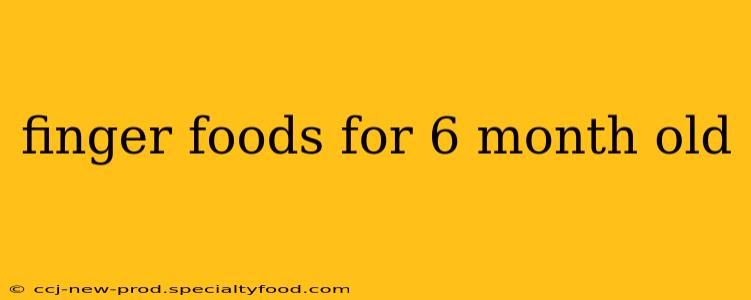Introducing solids to your 6-month-old is a significant milestone! It's an exciting time filled with new tastes and textures, but also a time for careful consideration of safety and nutrition. This guide will help you navigate the world of finger foods, ensuring your little one enjoys healthy and developmentally appropriate options.
What are the best finger foods for a 6-month-old?
The ideal finger food for a 6-month-old is soft, easily dissolvable, and large enough to be grasped but small enough to prevent choking. Think of foods that will easily mash or dissolve in their gums. Avoid anything hard, round, or sticky that could pose a choking hazard.
Here are some excellent choices:
- Soft Cooked Vegetables: Steamed or boiled carrots, sweet potatoes, green beans, and broccoli florets are excellent choices. Cut them into small, manageable sticks or pieces.
- Fruits: Well-cooked or ripe fruits like bananas (mashed or sliced into small, soft pieces), avocados (mashed or in small, soft pieces), and pears (steamed or pureed). Avoid grapes and berries whole as these are choking hazards.
- Plain Cooked Pasta: Small pasta shapes like ditalini or elbow macaroni are easy to grasp and dissolve. Make sure they are well-cooked and soft.
- Soft Tofu: Cubed or mashed tofu offers a good source of protein. Ensure it's soft enough to dissolve easily.
- Well-cooked Chicken or Fish: Flaked, well-cooked chicken or fish can be a nutritious addition, but ensure it is very soft and free of bones.
What should I avoid giving my 6-month-old?
- Whole Grapes: These are a major choking hazard.
- Nuts and Seeds: These are also major choking hazards.
- Popcorn: Hard and easily inhaled.
- Hard Cheeses: Can be difficult to chew and potentially cause choking.
- Hot Dogs: These are a notorious choking hazard.
- Honey: Never give honey to infants under 1 year old due to the risk of botulism.
- Sugary Foods and Drinks: Avoid processed foods, sugary drinks, and excessive salt.
Frequently Asked Questions (FAQ)
What are the signs of choking in a baby?
Recognizing the signs of choking is crucial. Look for these indicators:
- Inability to cry or make sounds.
- Skin turning blue or pale.
- Gasping for air.
- Clutching at their throat.
If you suspect your baby is choking, immediately contact emergency services and perform infant CPR if you're trained.
When should I start offering finger foods?
Most pediatricians recommend starting solids around 6 months, but it's essential to observe your baby's developmental cues. They should be able to sit upright with support, show interest in food, and have good head and neck control.
How many finger foods should I offer my 6-month-old?
Start with small portions, a few bites at a time, and observe your baby's response. Focus on offering a variety of textures and flavors to expand their palate.
My baby doesn't seem interested in finger foods. What should I do?
Some babies take time to adjust to new textures and tastes. Don't force them to eat, but continue to offer different options and be patient. If you have concerns, consult your pediatrician.
How do I prevent choking when giving my baby finger foods?
- Supervise your baby closely during mealtimes.
- Cut foods into small, manageable pieces.
- Offer foods that easily dissolve.
- Choose foods that are soft and easily mashed.
What are some good resources for more information on baby-led weaning?
Numerous websites and books offer guidance on baby-led weaning. Consult your pediatrician or other healthcare provider for tailored advice. Always prioritize safety and your baby's individual needs.
Remember, introducing solids is a journey. Be patient, encouraging, and always prioritize safety. This process is as much about exploration and learning as it is about nutrition. Enjoy this special time with your little one!
